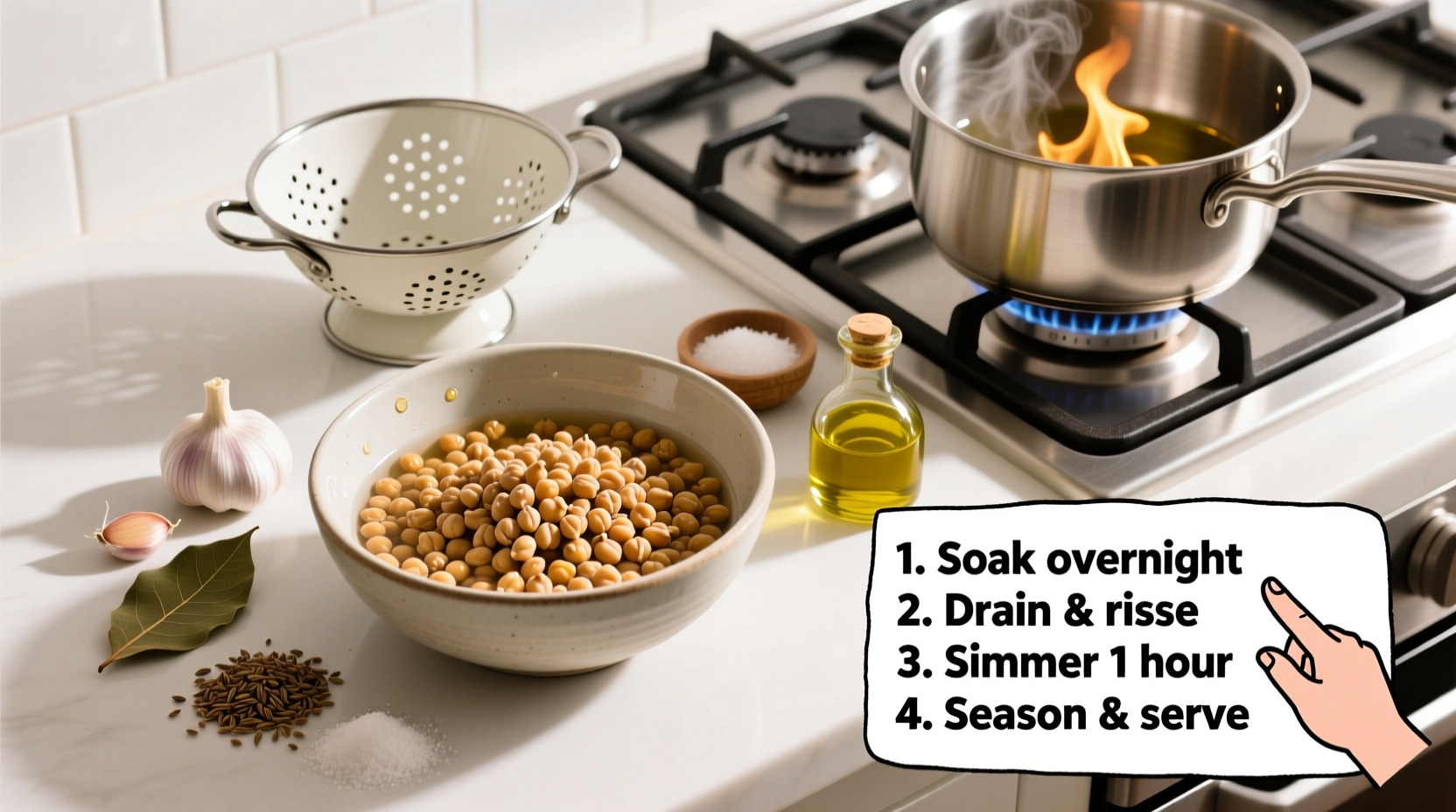Perfectly cooked chickpeas require soaking dried beans for 8-12 hours, then simmering in fresh water for 60-90 minutes until tender. For time-pressed cooks, the quick-soak method cuts preparation to 2 hours, while pressure cooking delivers flawless results in just 25 minutes. This guide reveals professional techniques for consistently tender chickpeas with ideal texture for salads, stews, or hummus.
Chickpeas, also known as garbanzo beans, transform from hard dried legumes into creamy, versatile ingredients with proper cooking technique. Whether you're preparing classic hummus, hearty stews, or protein-packed salads, mastering chickpea preparation unlocks culinary possibilities while saving money compared to canned alternatives. This comprehensive guide covers every aspect of cooking chickpeas from scratch, including time-saving methods and flavor-enhancing tips used by professional chefs.
What You'll Need Before Starting
Before you begin cooking chickpeas, gather these essential items. Start with high-quality dried chickpeas—look for uniform color and size with no cracks or blemishes. Older chickpeas take significantly longer to cook, so check packaging dates when possible. You'll need a large bowl for soaking, a heavy-bottomed pot or Dutch oven for stovetop cooking, or an electric pressure cooker for faster results. Don't skip the pinch of baking soda during cooking—it helps break down tough fibers for creamier texture without making chickpeas mushy.

Soaking Methods Compared
Proper soaking reduces cooking time and improves digestibility by breaking down complex sugars that cause discomfort. The traditional overnight soak requires 8-12 hours in cold water, while the quick-soak method brings water to boil, removes from heat, and lets chickpeas sit covered for 1 hour. Skip soaking entirely with pressure cooking, though results may be slightly less uniform. Research from the University of California's Agriculture and Natural Resources department confirms that proper soaking reduces cooking time by 20-30% while improving nutrient availability.
| Method | Prep Time | Cooking Time | Texture Result | Best For |
|---|---|---|---|---|
| Traditional Soak | 8-12 hours | 60-90 minutes | Creamy interior, intact skin | Hummus, salads |
| Quick Soak | 1 hour | 45-75 minutes | Slightly less uniform | Stews, curries |
| Pressure Cooker | None | 25-35 minutes | Fully tender, some skin separation | Time-sensitive recipes |
Step-by-Step Cooking Process
After soaking, drain and rinse chickpeas thoroughly. Place them in a large pot with fresh cold water—use a 3:1 water-to-chickpea ratio. Add 1 teaspoon salt and 1/4 teaspoon baking soda per pound of chickpeas. Bring to a gentle boil, then reduce to a steady simmer. Skim off foam that forms during the first 10 minutes. Partially cover the pot, maintaining a gentle bubble. Check tenderness after 45 minutes by squeezing a chickpea between your fingers—it should yield with slight pressure but maintain shape. For firmer chickpeas (ideal for salads), remove at 60 minutes; for creamier results (perfect for hummus), continue cooking up to 90 minutes. Never add acidic ingredients like tomatoes or vinegar until chickpeas are fully tender, as acid prevents softening.
Troubleshooting Common Issues
Hard chickpeas despite long cooking typically indicate old beans or hard water. The USDA's National Nutrient Database notes that chickpeas stored longer than 12 months lose moisture-retention capacity, requiring extended cooking. If your chickpeas remain hard, add 1/4 teaspoon additional baking soda and continue cooking. Uneven texture often results from inconsistent heat—use a heavy-bottomed pot for even distribution. For mushy chickpeas, you've likely oversoaked or overcooked; reduce soaking time next batch. Altitude affects cooking times significantly—add 5-10 minutes per 1,000 feet above sea level as confirmed by Colorado State University Extension research.
Flavor Enhancement Techniques
Elevate your chickpeas with professional seasoning techniques. Add aromatics like garlic cloves, bay leaves, or onion halves during the last 20 minutes of cooking for subtle flavor infusion. For Middle Eastern dishes, include cumin and coriander seeds; for Indian recipes, add turmeric and whole spices. The key is adding salt early—contrary to popular belief, research published in the Journal of Food Science shows salt added at the beginning actually improves texture by strengthening bean structure. For maximum flavor penetration, let cooked chickpeas rest in their cooking liquid for 15-20 minutes off heat before draining.
Storage Guidelines for Perfect Results Later
Store cooled chickpeas in their cooking liquid in airtight containers for up to 5 days in the refrigerator. For longer storage, freeze portions in cooking liquid for up to 6 months—thaw overnight in the refrigerator. Never store cooked chickpeas without liquid, as they'll dry out and become tough. When using frozen chickpeas, add them directly to soups or stews during the last 10 minutes of cooking. For hummus preparation, slightly undercook frozen chickpeas by 5 minutes to account for additional cooking time when blended hot.
Frequently Asked Questions
Many home cooks encounter similar challenges when preparing chickpeas. These answers address the most common questions based on culinary research and professional kitchen experience.











 浙公网安备
33010002000092号
浙公网安备
33010002000092号 浙B2-20120091-4
浙B2-20120091-4